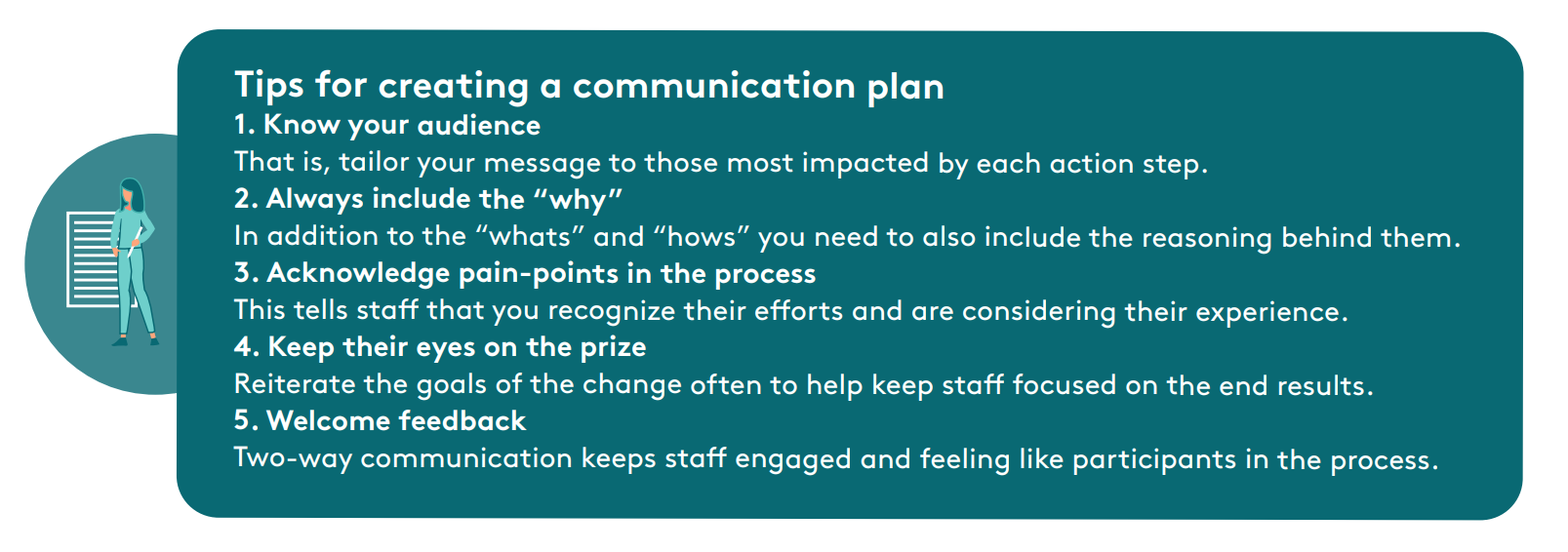The Change Management Challenge
Ensuring success through resistance management
Pressed for Time?
Watch the video to the right and get this white paper content in under 5 minutes— then come back for a deeper dive into our findings by scrolling to the full version below. Or let Haxall know you would like to download a pdf version for later."

Abstract
In today’s increasingly competitive healthcare environment, progress is essential to viability. From keeping up to date with the latest innovations in technology to adapting to evolving patient-consumer demands, today’s providers must strive to keep pace with their market peers or risk being consumed by them. It can be a daunting task because…
To make progress means to make change.
Change management in healthcare is especially difficult. Not only are there complex structures within a health system that must be brought together to ensure success, but there are also often areas where staff feel particularly attached to existing methodologies or ownership over established processes.
“In healthcare, change is even harder than in most industries. Clinical and administrative staff often view their work as a vocation as much as a profession, and they are historically suspicious of senior administrators and resistant to strategic agendas.”
– Jeffery Brickman, President and CEO of Central Maine Healthcare, Harvard Business Review
Some studies cite that as much as 70% of change initiatives fail. Many see this as a failure to properly plan or execute the steps necessary for fully adopting the new strategy. From our perspective, as an industry partner that facilitates process changes for healthcare organizations of various sizes and structures, is that more often the challenge isn’t the nuts and bolts of change management, it’s resistance management.
Part One: Identifying Resistance
Even the best-laid plans will fail if you do not have participation and commitment from the staff you need to implement them. It can be the instinct of leadership to play the role of enforcer, putting a plan into action and demanding participation on principle. This often just results in more, albeit quieter, resistance. Instead, resistance management should be incorporated into the strategy from the onset. This requires acknowledging that resistance to change is natural. Change often pulls people out of their comfort zone, requires extra work, and can come with the feeling of losing control. In fact, one might see resistance to change among staff as a positive thing: when people are committed to established methodologies it means they see value in the work they’re doing. When trying to implement change this kind of devotion can be used to your advantage if you understand where the resistance comes from and how to appeal to their concerns.
What camp are they in?
Regardless of their role in the organization, staff will fall into one of the following camps:

Innovators (2%)
Often a small group, or even a single person, innovators are the ones who developed the original idea for the change initiative. (If you are reading this then this is probably you.)
Early Adopters (13%)
This group represents those who validate the proposed initiative by throwing their full support behind it. They hop on board early and can be great allies for the cause because they believe in it too.
Early Majority (35%)
The people in this camp represent the first half of the silent majority. They tend to be less vocal about their concerns but can be easily swayed by the enthusiasm of the Early Adopters.
Late Majority (35%)
Slower to come around, the second half of the silent majority is usually convinced by the Early Majority.
Resistors (15%)
The last to be convinced, this smaller contingent of holdouts typically has strong opinions about why the idea will not work. Gaining their support will require addressing their concerns and collective buy-in from the rest of the team.
Types of Resistance
Logical Resistance
Resistors of this kind disagree with the logistics of the strategy being implemented. They believe the time and effort needed to adjust to the changes are not worth the long-term benefits. To appeal to these concerns, you must illustrate how the short-term challenges can be overcome. Use rationalities, facts, and logical reasoning to diminish this kind of resistance.

Psychological Resistance
This kind of resistance is emotional. These resistors may have an attachment to how things have “always been done” or the existing processes that would change. Their emotional response can also be related to a general distrust of upper management, dislike of the innovator leading the change, or feelings of insecurity regarding their personal role in it. Logic may be used to support arguments for the changes, but their feelings must be addressed to truly gain buy-in. Attitude and ego must be considered when trying to connect with resistors of this kind.

Sociological Resistance
This kind of resistance walks the line between logic and emotion. These resistors are most concerned with how the proposed change will impact the inner workings of the team. Since these types are hyper-focused on relationship dynamics, they are often capable of significant influence. This means it’s important to align them with the goals of the strategy as soon as possible— they can either be a fierce ally for the cause or a leading force in the resistance. Sway them by focusing on how the changes will have a positive impact on group interests and how they align with the values of the organization.

Complex Resistors
Naturally, some staff members will have a variety of concerns that span more than one category of resistance. These kinds of complex resistors are the hardest to convince yet often some of the most valuable to your organization as they are also typically the most invested in its success. Consider how resistance types overlap in the following profile.

Despite not providing details for the proposed change in our sample scenario, it’s easy to understand this physician’s perspective. This illustrates an important point: most of the resisting staff’s concerns are valid from their unique position in the environment of change. Keeping this in mind will not only better position you to solicit buy-in and address the root cause of their resistance, but also ensure a smoother transition for the change itself as you would have broadened your view of its impact prior to implementation.
Part Two: Overcoming Resistance
Good communication can do most of the work when it comes to bringing staff on board. A communication plan should detail not only what to expect at each stage of the implementation but the goal and benefits of making these changes. This will help to reinforce your messaging and keep staff aligned with the big picture. Additionally, clearly communicating action steps and goals (and then achieving them) can help build trust throughout the change process. This is especially valuable for bringing on certain resistors, especially those experiencing psychological resistance to the new strategy. For the small camps of resistors, frequent engagement and one-on-one communication may be beneficial in addition to a well thought-out communication plan.

Nudge Theory
“Nudge Theory” was developed by behavioral economist and Nobel prize winner Richard Thaler. The theory illustrates how to “nudge” individuals into making certain choices by the way the choices are presented. The concept of “choice architecture” can be helpful in negating resistance in change management. A softer approach, nudging staff offers them an opportunity to come aboard willingly and avoid the need for harsh enforcement.

Perhaps one of the things that most lends to the success of using “nudge theory” in the context of change management is that it forces the innovators (leadership or agents of change) to consider the perspective of the employees it will impact. Using this strategy also has a better chance of promoting long-term buy-in as it encourages staff to play an active role in the decision process, keeping them invested in a successful outcome.
Change Champions
Change Champions are your secret weapon for managing resistance. These respected team members can be found in the “Early Adopter” camp and their enthusiasm and dedication to the cause can help influence resistance groups. They are also valuable facilitators in the communication process. Identify your Change Champions early in the planning stages so you can equip them with the tools necessary to illustrate value and address concerns as they arise from other staff members.

Utilize Change Champions as the first point of contact. They can be perceived as more approachable by staff, particularly those in the “silent majority” groups who may be more reserved about expressing concerns. Where possible select a Change Champion from each department or area of practice that will be impacted. Having a peer lead the communication plan will not only be better received, but it will also be better understood as they have the unique ability to speak to the same experiences and pain-points as the staff they are trying to bring on board.

Change Champions are essential to the success of resistance management. Beyond delivering key messaging, they can act as eyes on the ground for leadership identifying complex resistors and identifying issues as they arise.
Conclusion
No progress is made without some challenges. In order to successfully execute change management, you must also account for a degree of inevitable resistance— and the key to managing resistance lies in connecting with the people in your organization.
“People don't resist change. They resist being changed.”
-Peter Senge, scientist, MIT professor, author
A good communication plan that keeps staff engaged throughout the implementation process paired with the deployment of respected peer advocates can ease difficulties in new process adoption and the minds of resistors. Garnering participation from all levels of staff and encouraging feedback early on allows you to gain new perspectives about the impact of the proposed strategy so issues can be mitigated issues before they arise, and the concerns of staff can be quickly addressed to minimize pushback.
Sources:
1. Brickman, J. (2017, April 5). How to get health care employees onboard with change. Harvard Business Review. Retrieved August 8, 2022, from https://hbr.org/2016/11/how to-get-health-care-employees-onboard-with change.
2. Faeste, L., Reeves, M., & Whitaker, K. (2022, March 4). The Science of Organizational Change. BCG Global. Retrieved August 8, 2022, from https://www.bcg.com/publications/2019/science-organizational-change
3. Kellogg School of Management (2021). Module 2: Organizing for Change [Online Course]. In E. Smith, Strategic Change Management: Lead and implement change in your organization https://www.kellogg.northwestern.edu/executive-education/individual-programs/online-programs/ol-scm.aspxffff
4. University of Lucknow. (2020, March 29). Management of Strategic Change. Retrieved August 8, 2022, from https://lkouniv.ac.in/site/writereaddata/UploadNews/pdf/C_202109271733207880.pdf
5. UBS.com. (n.d.). Richard H. Thaler. Nobel Perspectives. Retrieved August 8, 2022, from https://www.ubs.com/microsites/nobel-perspectives/en/laureates/richard-thaler.html
6. solonline.org. (2018, August 14). Peter Senge. Retrieved August 8, 2022, from https://www.solonline.org/peter-senge/
About Envera Health
Envera Health provides comprehensive engagement partnerships for healthcare organizations seeking to transform the patient experience and simplify the care deliver y process. Supported by a unique CRM-driven engagement center, we other a complete suite of patient engagement solutions custom-designed to improve operational efficiency and enable steady growth.
